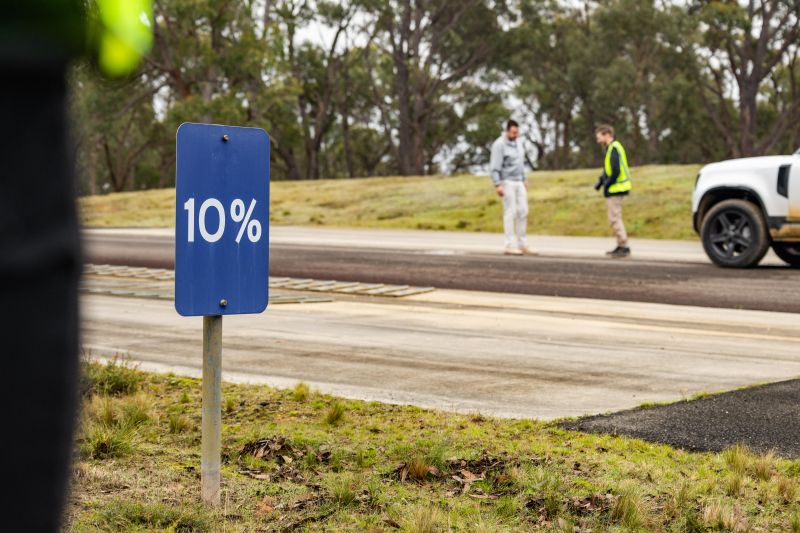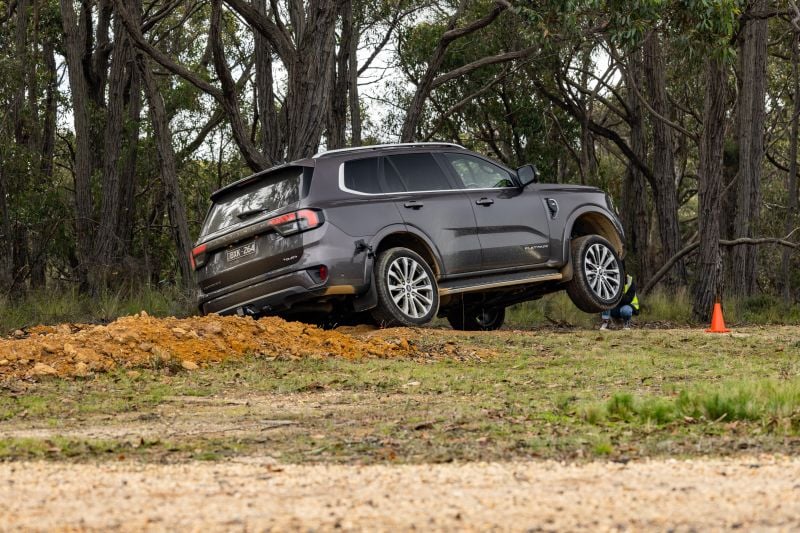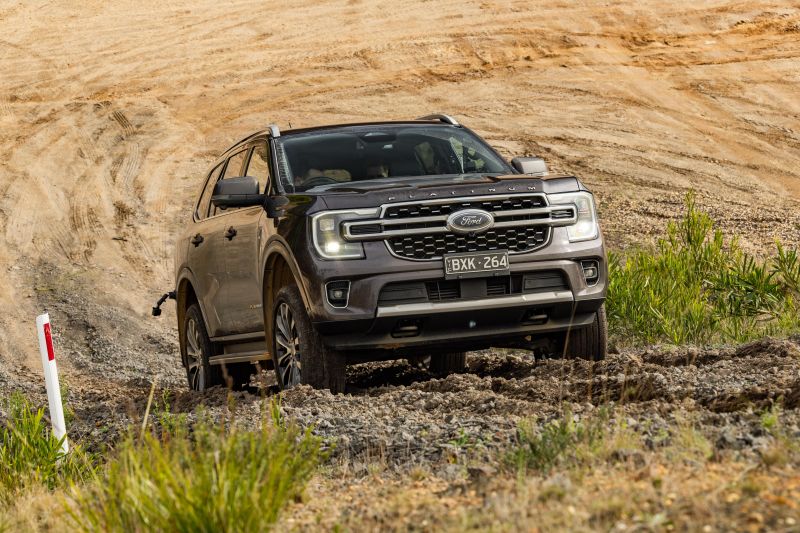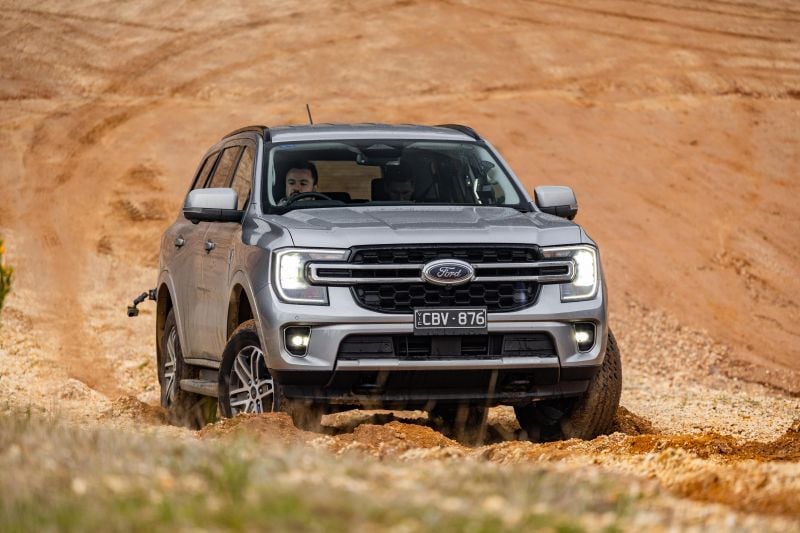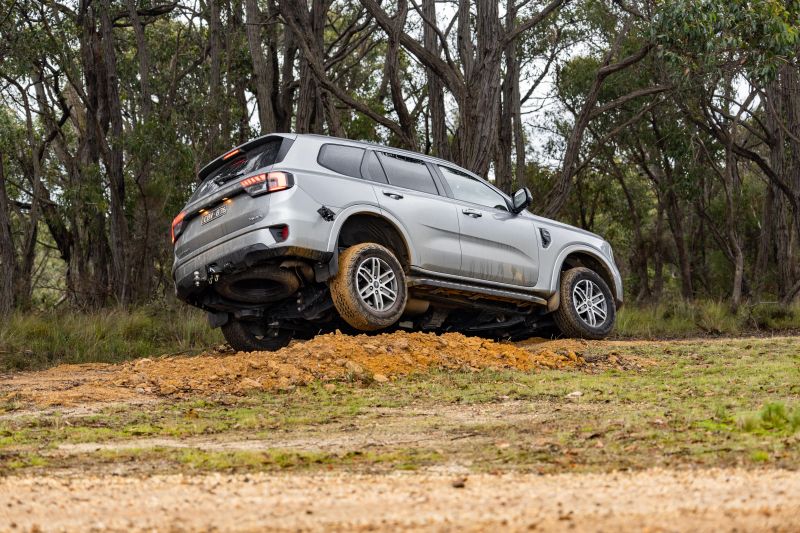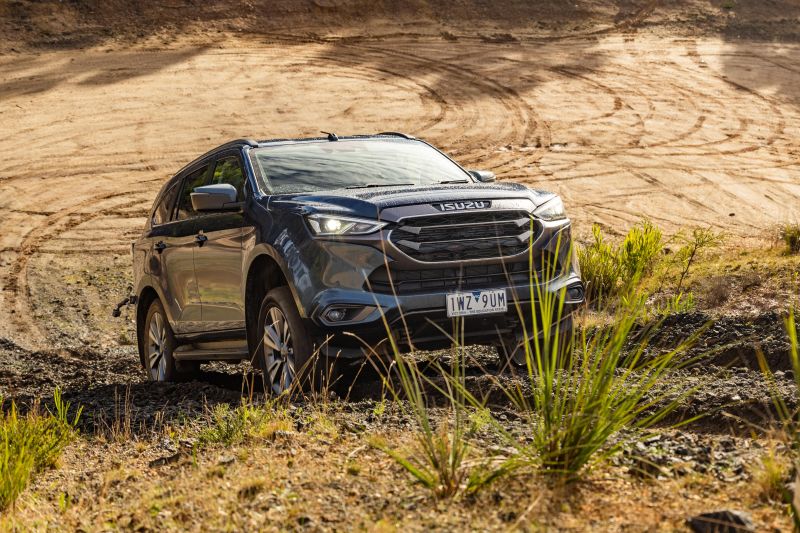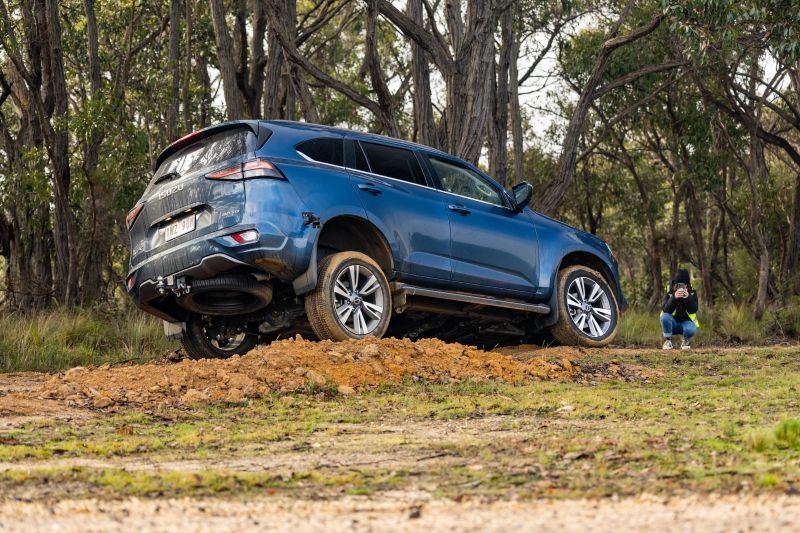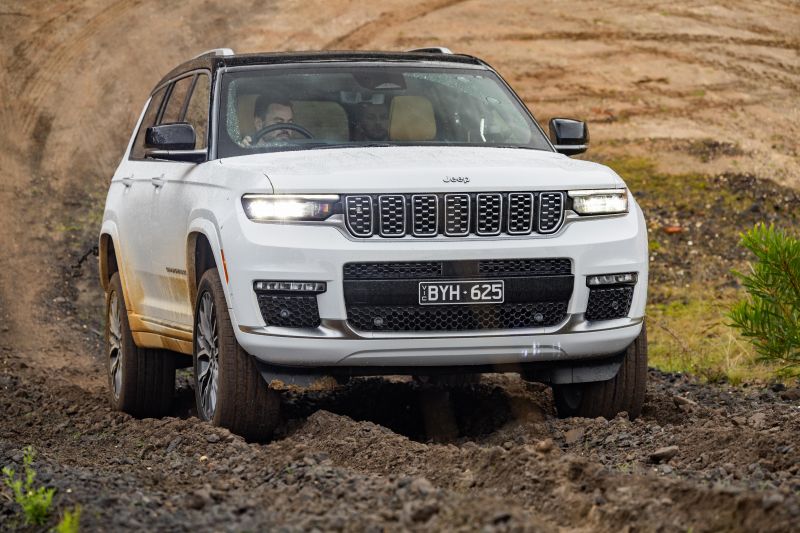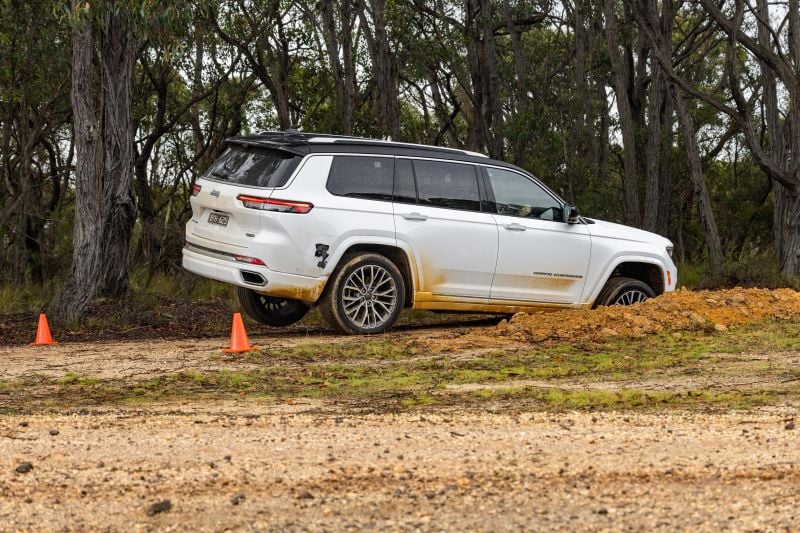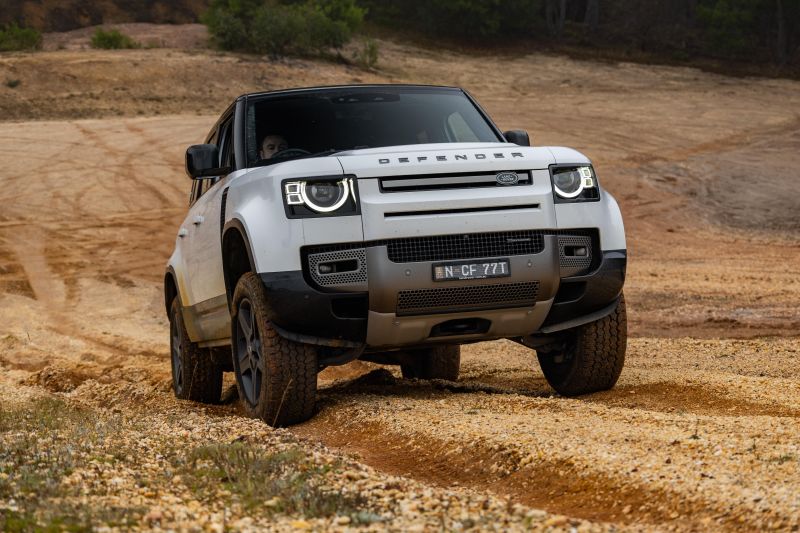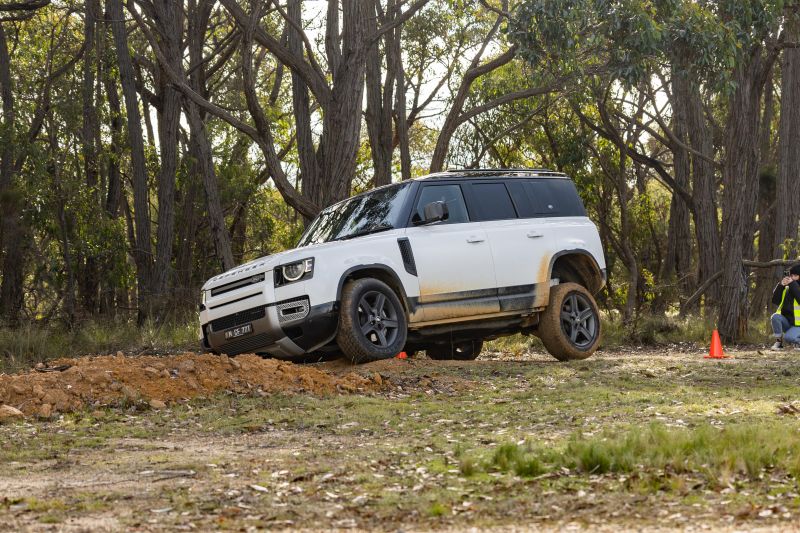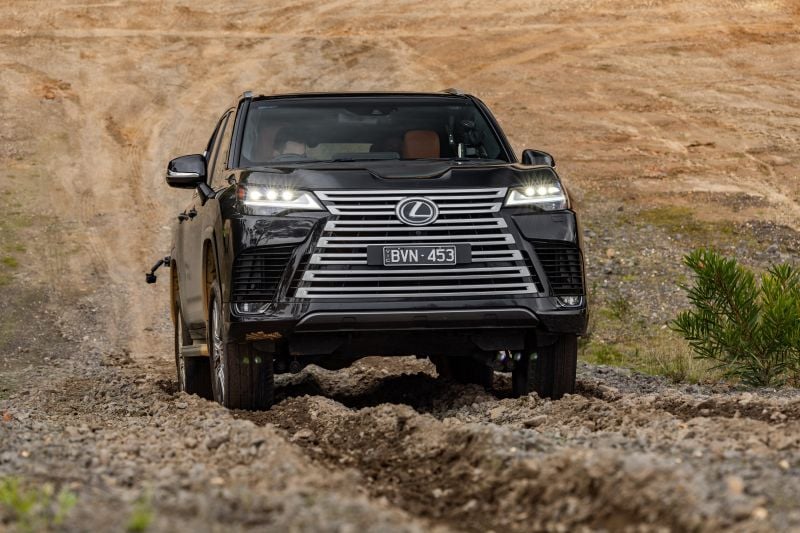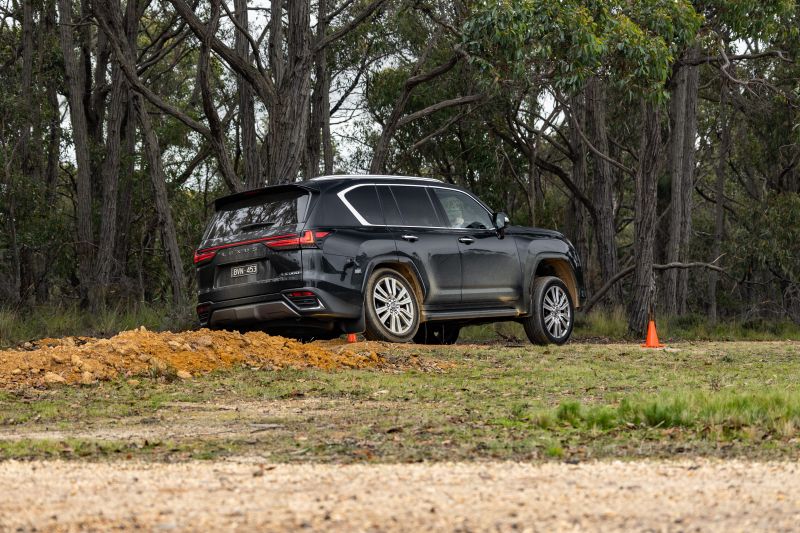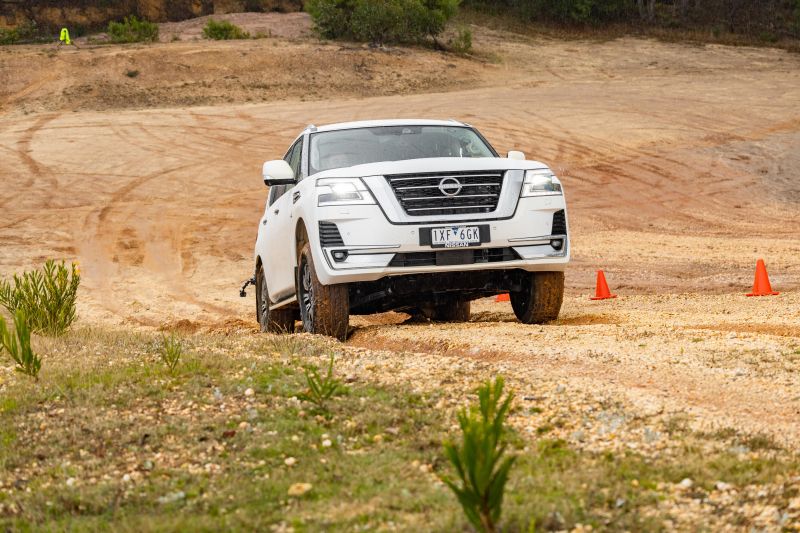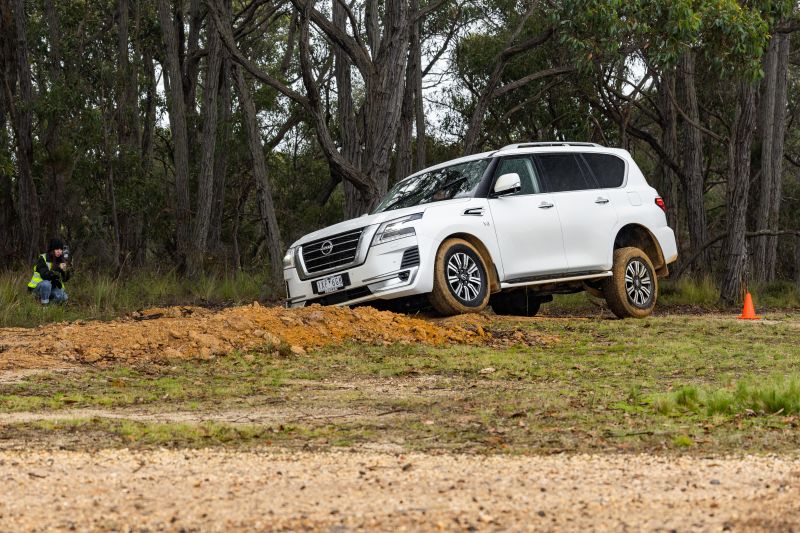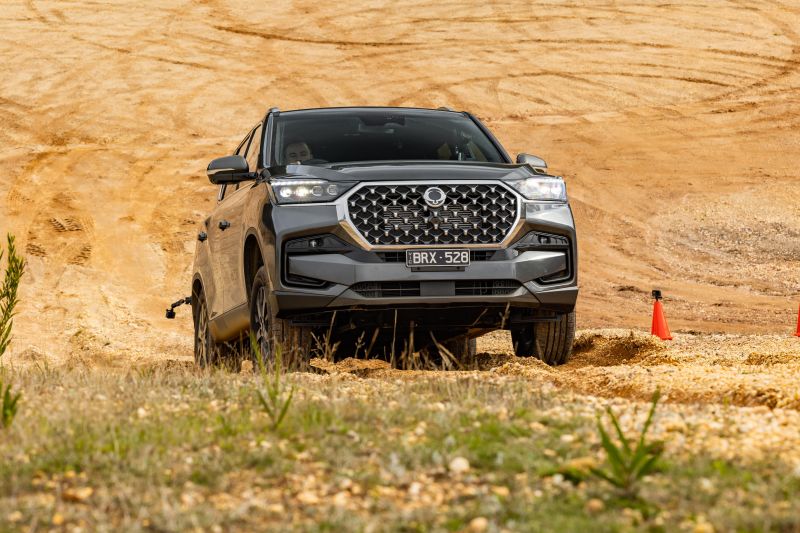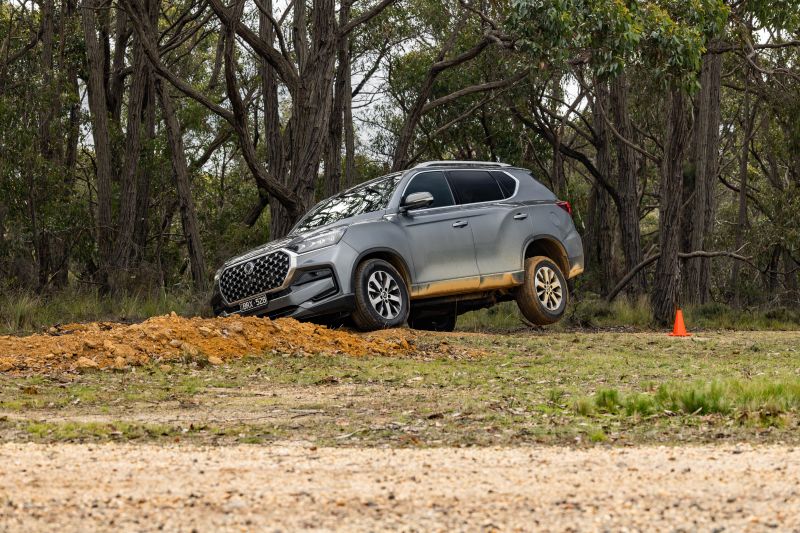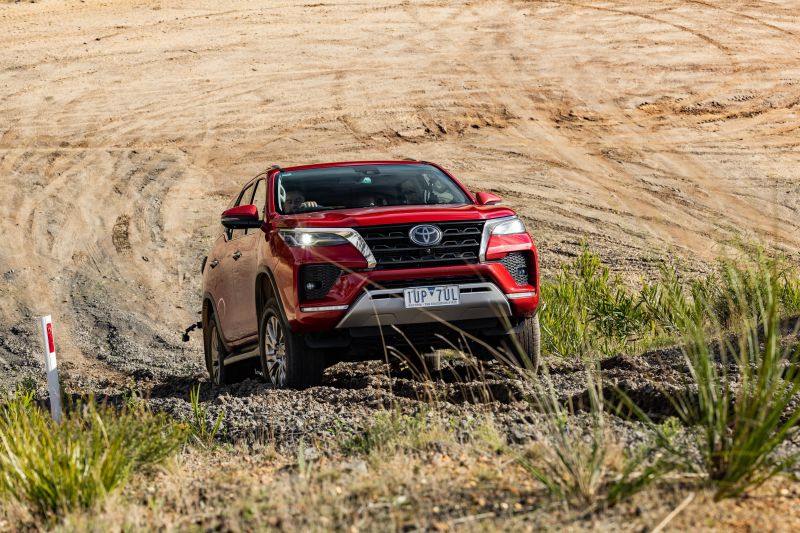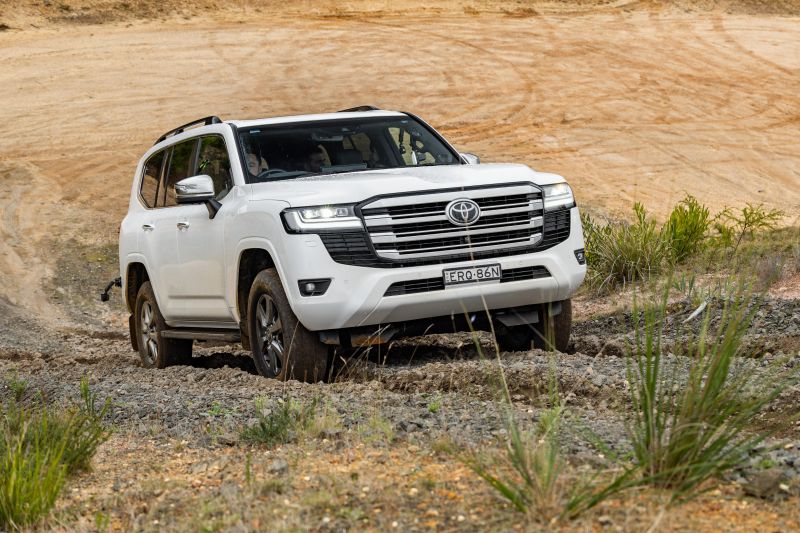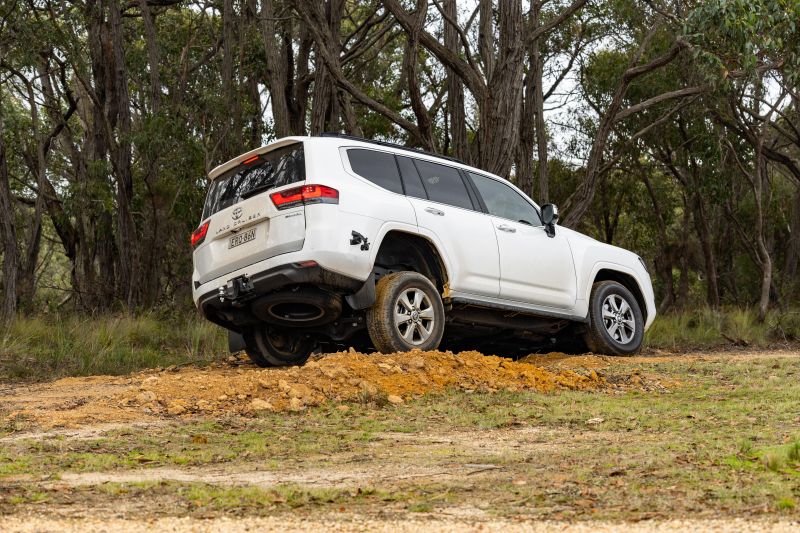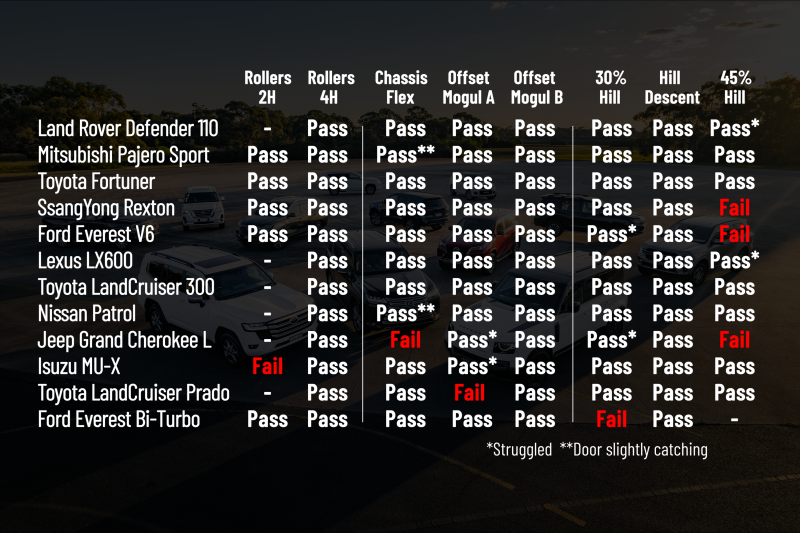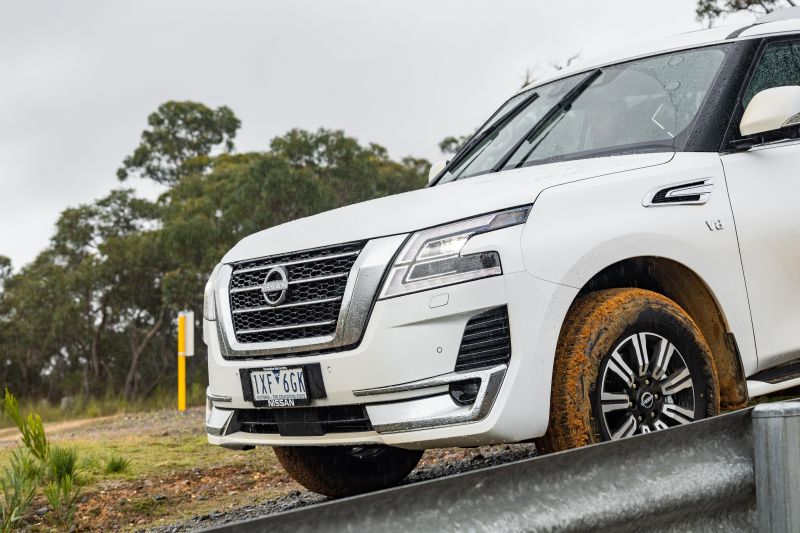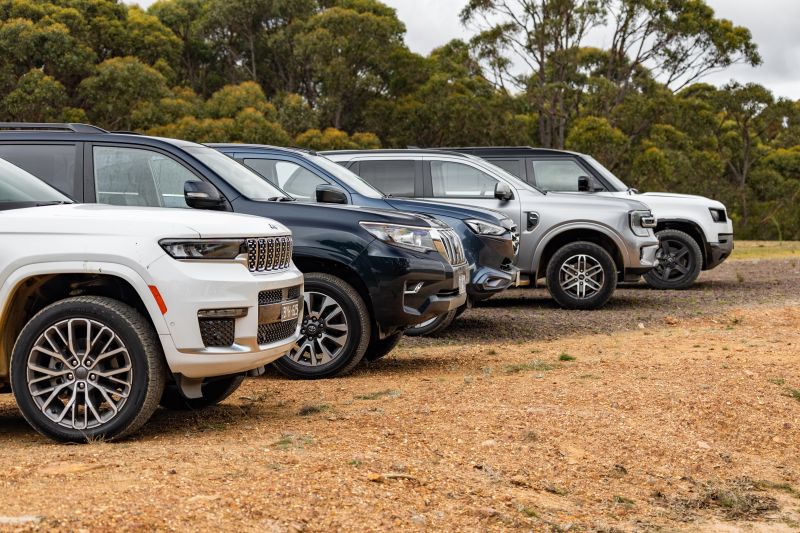Along with towing, one of the things Australians love doing with their 4WD SUVs is heading off-road. But how far will yours actually go into the wilderness?
That’s where our off-road test comes in. Using the Australian Automotive Research Centre (AARC) near Anglesea in Victoria, we prepared a series of challenges designed to test their body rigidity, 4WD systems, traction control, and ground clearance.
The focus here isn’t on breaking cars or getting bogged. We’ve tried to make the tests reflective of how an owner might use their car – accessing a campsite or lookout on a family holiday, for example – which is why each car is running on their factory-fit tyres at placarded pressures.
If you are a regular off-roader, then consider the aftermarket for things like chunkier tyres, more underbody protection, and even potentially some suspension upgrades.
To be eligible to be included in this test, vehicles needed to have 7-seat capability, along with low range. The only vehicles that met the brief that weren’t here were the LDV D90 (LDV declined to be involved), the Land Rover Discovery 5 and the Range Rover (both JLR products were at events).
The tests
Rollers
We drove the vehicles’ right-hand wheels onto a set of rolling metal tubes, set on a 10 per cent grade.
This simulates a variable, slippery surface. By removing grip from one side of the car, the rollers test the effectiveness of each vehicle’s traction controls – how quickly and efficiently it can direct torque to the tyres in contact with the road.
We tested the vehicles in rear-wheel drive (2H) to establish a control, and then 4×4 (4A in full-time 4WD SUVs, and 4H in part-time 4×4 SUVs).
Offset moguls
Each 4WD SUV was stopped with two wheels (diagonally opposed) airborne, and two planted.
The first test was to open the doors in this position to make sure the chassis wasn’t flexing. If the door opens and closes smoothly with two corners sagging, the car passes – if it catches or won’t close, it fails.
The second test involved steadily accelerating out of the mogul and observing traction controls to see how each SUV clambered out.
That allowed us to watch how the 4WD and traction control systems allocate engine outputs to the tyres with road contact, rather than letting the airborne wheels spin freely.
Vehicles were driven in their 4A or 4H modes based on whether they were full-time or part-time four-wheel drives.
We didn’t engage rear or centre diff locks for this test – although some cars had automated rear differential locks or limited slip rear differentials.
Hillclimbs and hill descent
You might be familiar with Gravel Mountain from our ute mega test. But what about its little brother, Mogul Mountain?
The first part of this test was to send each SUV up a 30 per cent gradient rutted hill lined with offset moguls in 4L. Combined with the damp clay surface, the moguls present a stern test for each vehicle’s four-wheel drive system.
Vehicles capable of conquering the 30 per cent gradient then faced Gravel Mountain. It’s a steeper 45-degree incline covered in loose gravel and stone, which proved highly difficult to walk up, let alone drive.
We started at the bottom in low-range (4L) gearing with the relevant differential locks engaged where possible. Differential locks allow both wheels on the axle to turn at the same speed, maximising surface purchase, or allow 50 per cent of torque to be allocated between the front and rear axles.
We then turned around and went down the same hill, to test the hill-descent control effectiveness, the low-range gearing, and the camera views where relevant.
The competitors
| Vehicle | Engine | Fuel | Outputs | Trans. | 4×4 | Diff. lock(s) | Clearance | Tyres |
|---|---|---|---|---|---|---|---|---|
| Everest V6 | 3.0L V6 turbo | D | 184kW/600Nm | 10AT | 2H, 4A, 4H, 4L | Rear | 229mm | HT |
| Everest Bi-Turbo | 2.0L 4-cyl turbo | D | 154kW/500Nm | 10AT | 2H, 4A, 4H, 4L | Rear | 229mm | AT |
| MU-X | 3.0L 4-cyl turbo | D | 140kW/450Nm | 6AT | 2H, 4H, 4L | Rear | 235mm | HT |
| Patrol | 5.6L V8 | P | 298kW/560Nm | 7AT | 4A, 4H, 4L | Rear | 273mm | AT |
| Grand Cherokee | 3.6L V6 | P | 210kW/344Nm | 8AT | 4A, 4L | N/A | 276mm | Road |
| Defender 110 | 3.0L I6 turbo | D | 220kW/650Nm | 8AT | 4A, 4L | Centre, rear | 228mm | AT |
| LX600 | 3.4L V6 turbo | D | 305kW/650Nm | 10AT | 4A, 4H, 4L | Centre | 205mm | HT |
| Pajero Sport | 2.4L 4-cyl turbo | D | 133kW/430Nm | 8AT | 2H, 4A, 4H, 4L | Rear | 218mm | HT |
| Rexton | 2.2L 4-cyl turbo | D | 148kW/441Nm | 8AT | 2H, 4H, 4L | Rear | 203mm | Road |
| Fortuner | 2.8L 4-cyl turbo | D | 150kW/500Nm | 6AT | 2H, 4H, 4L | Rear | 216mm | Road |
| LandCruiser 300 | 3.3L V6 turbo | D | 227kW/700Nm | 10AT | 4A, 4L | Centre | 245mm | AT |
| LandCruiser Prado | 2.8L 4-cyl turbo | D | 150kW/500Nm | 6AT | 4A, 4L | Rear | 220mm | AT |
Ford Everest Platinum V6
The Everest mimicked the Ranger ute, smoothly driving out of the rollers regardless of which four-wheel drive mode was active – it was more impressive in 4A than 2H, however, with slightly less slip backwards.
As expected, the Everest passed our flex test without any issues.
It also walked through the offset moguls in 4A mode, smartly shuffling torque to the grounded wheels to drag the car out. It was the same situation in 4H with the rear differential unlocked, and the car set to Mud/Ruts mode.
The Everest did touch down slightly, indicating it had less ground clearance than some of its rivals.
Despite a bit of wheelspin brought about by its road-oriented tyres, the Everest V6 did an impressive job shuffling torque around to climb Mogul Mountain with a constant throttle.
Ford’s hill-descent control is the best in the business, allowing the driver to adjust speed using the cruise control buttons. The lack of ugly noises from the brakes is also impressive.
Gravel Mountain challenged the Everest; it failed to scale it on the third attempt despite a healthy serving of the throttle – potentially due to its highway-terrain tyres.
If you’re looking to buy a Ford Everest, we can connect you with vetted dealers for the best deal and let you know what everybody else has paid. Just head to the Ford Everest deals page!
Ford Everest Bi-Turbo
The Everest mimicked the Ranger ute, smoothly driving out of the rollers regardless of which four-wheel drive mode in active – it was more impressive in 4A than 2H, however, with slightly less slip backwards.
As expected, the Everest passed our flex test without any issues.
It also dealt well with the offset moguls in 4A mode, shuffling torque to the grounded wheels to drag the car out – although it did exhibit more wheel spin than the V6.
It was the same situation in 4H with the rear differential unlocked, and the car set to Mud/Ruts mode. The Everest did touch down slightly, indicating it had less ground clearance than some of its rivals.
Mogul Mountain was too much for the Everest Bi-Turbo to conquer, regardless of drive mode.
Even with the rear differential locked, it wasn’t able to crest one of the humps on our climb on three attempts. As such, it wasn’t run up Gravel Mountain.
Ford’s hill-descent control is the best in the business, allowing the driver to adjust speed using the cruise control buttons. The lack of ugly noises from the brakes is also impressive.
If you’re looking to buy a Ford Everest, we can connect you with vetted dealers for the best deal and let you know what everybody else has paid. Just head to the Ford Everest deals page
Isuzu MU-X
Like the D-Max, the MU-X slid all the way to the end of our rollers in both 2H and 4H modes. With Rough Terrain mode activated, however, it managed to take off and drive out the end of the rollers.
The Isuzu successfully handled the flex test, but in 4H mode couldn’t drive itself out of the offset moguls.
With Rough Terrain mode active and a bit of wheel work, it managed to claw its way out – albeit after more time and wheel spin than anything else on test.
Although it wasn’t what you’d call effortless up Mogul Mountain, the MU-X did successfully handle our first climb without too much wheel spin or fuss.
Hill descent control was effective – where we had problems with the D-Max, coming to a full stop before descending in the MU-X appeared to solve them. The system did a good job keeping the car’s mass in check.
The MU-X also successfully summited Gravel Mountain, and did it without any great fanfare. It just chugged on up in 4L with the rear differential locked, and did it on the first attempt.
If you’re looking to buy a Isuzu MU-X, we can connect you with vetted dealers for the best deal and let you know what everybody else has paid. Just head to the Isuzu MU-X deals page!
Jeep Grand Cherokee L
The Grand Cherokee L followed in the footsteps of the Gladiator by doing a solid job getting up the rollers. It wasn’t quite as smooth as the absolute best on test, but also didn’t slide backwards like some of its rivals.
Unfortunately, it did poorly in the flex test, with the door catching on the body while the wheels were hanging.
In the offset moguls, the car was “okay but not amazing”. The traction control needed to work quite hard to get the car out, but it did drag itself out of the moguls eventually.
Mogul Mountain exposed the limitations with the highway tyres on the Grand Cherokee L Summit Reserve. It had to work hard, but the smart traction control system was smart enough to use what little traction was available.
Hill descent control was effective, and allowed you to adjust its speed using the paddles behind the steering wheel.
Gravel Mountain was out of reach, however. Following the offset mogul it also developed a rattle in the back door that remained after the test was complete.
If you’re looking to buy a Jeep Grand Cherokee, we can connect you with vetted dealers for the best deal and let you know what everybody else has paid. Just head to the Jeep Grand Cherokee deals page!
Land Rover Defender 110 D300
The Defender has a reputation for going anywhere, and it excelled in our testing.
It didn’t roll back at all on the rollers, with the active central and rear differential immediately locking to drag it up the hill with no fuss.
Wheel articulation was excellent over the offset moguls, and the Defender passed the door test with flying colours. Paul did notice a squeaky seal on one of the doors over uneven surfaces, however.
Its 4WD systems dealt with two wheels being in the air effortlessly, with almost no wheel spin or jerking on the way out of the ruts. The added articulation thanks to air suspension meant that the wheels rarely left the ground.
As for the hillclimbs? Mogul Mountain was dispatched with a minimum of fuss, and it scrabbled up Gravel Mountain on the third attempt – with more throttle than its first attempt and the air suspension set to its “Normal” height the car made it to the top of the hill. An upshift at the top of the hill killed some momentum.
Hill-descent control kept the car’s considerable mass in control nicely. It’s worth noting the Defender was the first car up Gravel and Mogul Mountain.
If you’re looking to buy a Land Rover Defender, we can connect you with vetted dealers for the best deal and let you know what everybody else has paid. Just head to the Land Rover Defender deals page!
Lexus LX600
The LX600 didn’t roll back at all on our rollers, cruising out with a minimum of fuss.
It passed our flex test with no trouble, and the traction control apportioned torque to the wheels that were on the ground after a hint of wheel spin. The amount of wheel articulation on offer was impressive.
The way it walked up our Mogul Mountain on highway tyres was effortless, with barely any slip, and the hill descent control kept what is a massive, heavy bus in check with a minimum of fuss.
With the centre differential locked, the LX600 summited Gravel Mountain on the third attempt. There was some slip, but it scrabbled through with a decent helping of throttle.
We also tested Crawl Control, which is like an off-road cruise control system that keeps the wheels spinning at a set speed.
If you’re looking to buy a Lexus LX, we can connect you with vetted dealers for the best deal and let you know what everybody else has paid. Just head to the Lexus LX deals page!
Mitsubishi Pajero Sport
The Pajero Sport performed reasonably well on the rollers, rolling back slightly in 2H before the traction control worked things out – it was very impressive in 4H, moving forward with barely any slip.
Its age showed in the flex test, where the door caught slightly on the body. It wasn’t the worst performer in that test, however.
Mitsubishi’s traction control system walked the car out of the moguls with a minimum of fuss, even in the road-oriented 4A four-wheel drive setting. With 4H and Mud Mode engaged it was “even more effortless”.
It scaled Mogul Mountain without too much wheel slip, and the hill-descent control kept the car nice and controlled. Using the throttle you can make the car descend faster, although you can’t use the cruise control buttons to do it as in some rivals.
Rev flaring was noticeable in the Pajero Sport going up Gravel Mountain, but it managed to scale the hill on the second attempt with its rear differential locked.
If you’re looking to buy a Mitsubishi Pajero Sport, we can connect you with vetted dealers for the best deal and let you know what everybody else has paid. Just head to the Mitsubishi Pajero Sport deals page!
Nissan Patrol
The Patrol had no trouble with the rollers, driving off without rolling back at all.
As one of the oldest cars on test here, it’s perhaps not surprising that the Patrol had its door catch slightly on the flex test – it still wasn’t the worst, however.
It waltzed through the offset moguls, particularly in reverse, with barely any fuss. The same can be said for Mogul Mountain, up which the Patrol crawled on a steady throttle.
Hill descent control lacks the level of adjustability you get in newer vehicles such as the Everest, but kept the Patrol in check nicely down Gravel Mountain.
Speaking of Gravel Mountain, the Patrol was a standout. Even without all the bells and whistles of the new LandCruiser 300, it barely broke a sweat going up a hill that conquered significantly more expensive metal.
If you’re looking to buy a Nissan Patrol, we can connect you with vetted dealers for the best deal and let you know what everybody else has paid. Just head to the Nissan Patrol deals page!
SsangYong Rexton
The Rexton’s automatically-locking rear differential meant it crawled out of the rollers with very little slip in both 2H and 4H, although the way it engages is quite sharp. It also doesn’t give the driver any control over when it kicks in.
There were no problems with the Rexton in our flex test, with the door opening and closing without catching.
The rear differential lock engaged after a few seconds on the moguls, helping to shove the Rexton out of trouble. But it’s an “unsophisticated” way of doing things, given the driver has no control over when it engages – or disengages.
With a decent dose of throttle, the Rexton managed to scale Mogul Mountain. The rear differential engaged and appeared to stay engaged, which was positive.
Hill descent control was “quite sloppy”, initially allowing the car to go too fast and then bringing the car to a complete stop before the bottom.
Gravel Mountain proved too much for the Rexton, which stopped a third of the way up on all three attempts.
If you’re looking to buy a SsangYong Rexton, we can connect you with vetted dealers for the best deal and let you know what everybody else has paid. Just head to the SsangYong Rexton deals page!
Toyota Fortuner
The Fortuner slipped back slightly on the rollers in 2H, before the traction control figured things out. It barely moved back at all in 4H, driving off with a minimum of fuss.
Body rigidity was impressive in our flex test, with no catching from the door.
After a hint of wheelspin from the hanging wheels, the traction control did a good job allowing the Fortuner to clamber out of the offset moguls. Like the HiLux, the Fortuner went about its business with a minimum of fuss.
It effortlessly scaled Mogul Mountain in 4L with the rear differential unlocked, even on highway tyres.
Hill-descent control was quite noisy, but kept the big Toyota in check – it was slightly too quick for Paul’s taste, but did the job regardlessly.
The Fortuner made it up Gravel Mountain on the second attempt, with the rear differential locked and a decent serving of throttle.
If you’re looking to buy a Toyota Fortuner, we can connect you with vetted dealers for the best deal and let you know what everybody else has paid. Just head to the Toyota Fortuner deals page!
Toyota LandCruiser 300
Like its Toyota and Lexus stablemates, the LandCruiser 300 had no trouble on the rollers – it barely slid backwards before crawling up the hill in 4A, despite the tarmac also being slightly greasy due to typical Victorian autumn weather.
In mud mode, the LandCruiser passed the door flex test with flying colours. Although the plastic air dam below the front bumper scraped slightly, the big Toyota had no trouble navigating the moguls.
It took a second to work out what was going on, but once it did the system smartly apportioned torque to the grounded wheels.
Mogul Mountain showed the LandCruiser has impressive wheel articulation. It cruised up with barely a hint of wheel slip.
Hill-descent control kept the car’s mass in check nicely downhill, and the on-the-fly speed adjustments were effective.
Gravel mountain caused the LandCruiser no trouble, with its all-terrain tyres no doubt helping it relative to the related Lexus LX600. Crawl control also was effective.
If you’re looking to buy a Toyota LandCruiser, we can connect you with vetted dealers for the best deal and let you know what everybody else has paid. Just head to the Toyota LandCruiser deals page!
Toyota LandCruiser Prado
The Prado is due for replacement, and its age was evident in a few places.
Although it took care of the rollers without too much slip, the traction control system is noticeably noisier than that of the newer Fortuner and LandCruiser.
Some flex was evident in the door test, and the Prado got stuck in the offset moguls. Once again, the traction control was noticeable in a way it wasn’t in other vehicles.
Mogul Mountain initially caused problems for the Prado, although locking the central differential allowed it to summit the climb with some difficulty. Hill-descent control was noisy, but effective.
Gravel Mountain caused the Prado no problems at all, once we turned all the off-road hardware on and got the traction control out of the way.
It summited the climb with the rear and central differentials activated in 4L.
If you’re looking to buy a Toyota LandCruiser Prado, we can connect you with vetted dealers for the best deal and let you know what everybody else has paid. Just head to the Toyota LandCruiser Prado deals page!
Results
The winners
The overall winner for our off-road test is the Nissan Patrol.
It’s an old dog at this point, but it still has the tricks to keep up with newer rivals packing broader suites of off-road assists – and better them in most cases. The fact it sounds so good doing it is a bonus.
If you want even more from your Patrol, there’s always the Warrior variant that’s recently been revealed and due here before the end of the year. Side pipes, anyone?
On the four-cylinder front, it was another old campaigner that took the cake.
The Mitsubishi Pajero Sport dealt with our hillclimbs with aplomb, and it’s clear someone who really knows what they’re doing has calibrated the traction control.
The fact you’re able to drive in four-wheel drive on sealed surfaces also elevates it above the Rexton and MU-X.
As was the case with the Triton, the Pajero Sport punches well above its weight.
Click the images for the full gallery
MORE: Best 4WD SUV drag race
MORE: Best 4WD SUV performance test
MORE: Best 4WD SUV towing test

